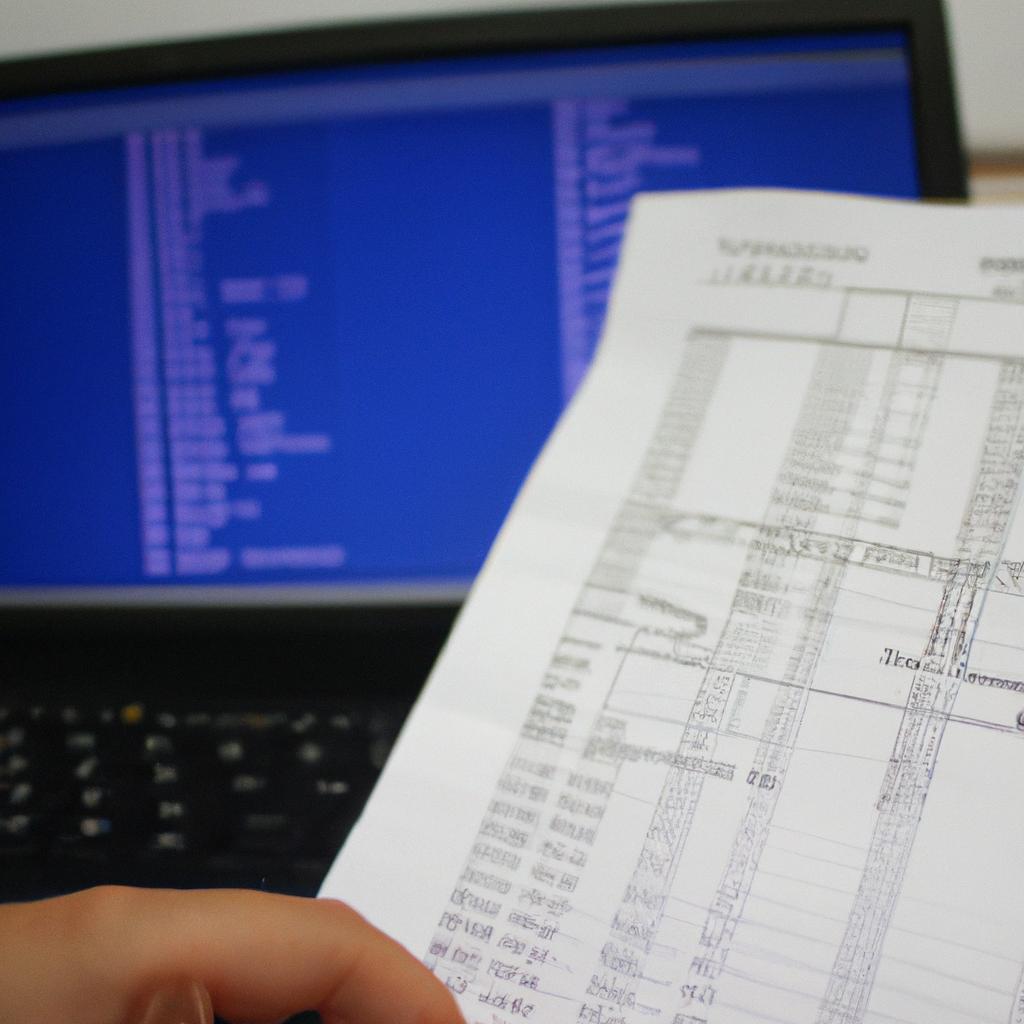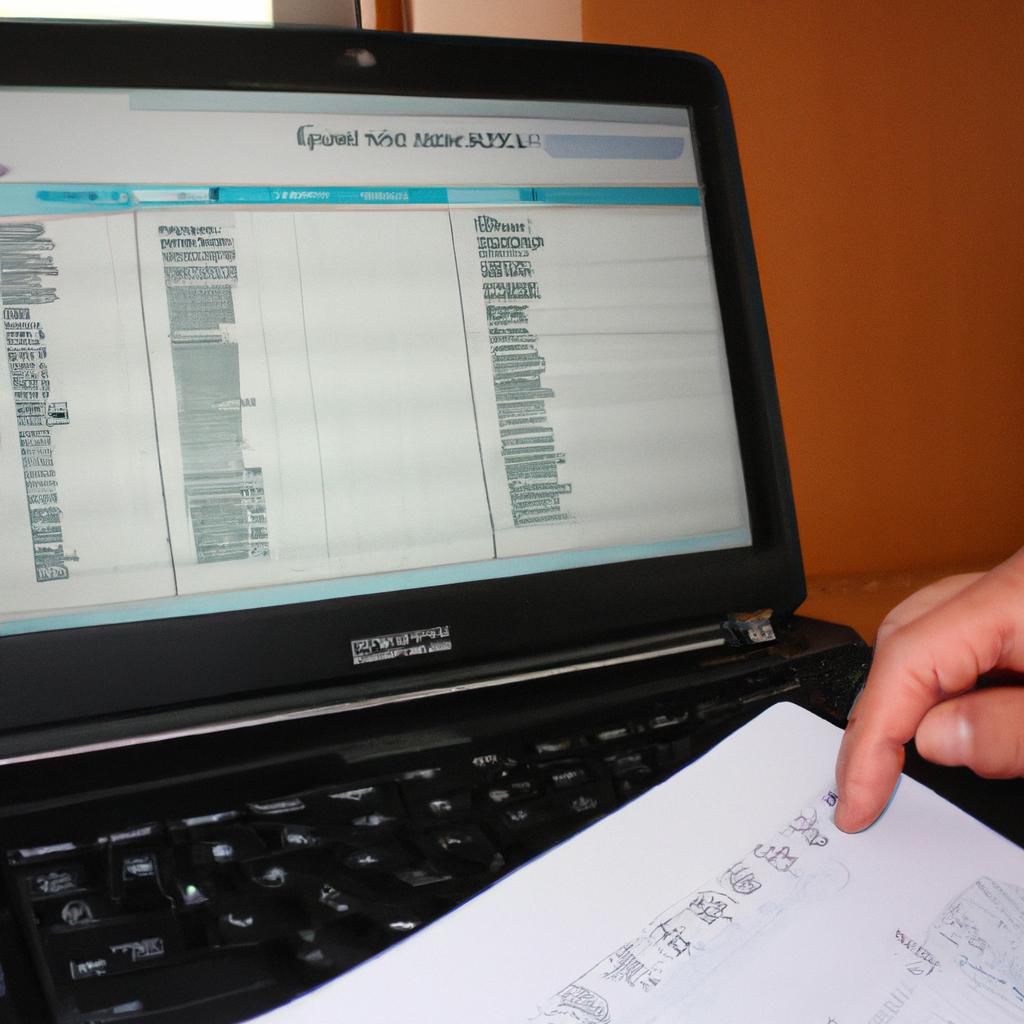Tax Calculation for Payroll Management: Accounting Software Perspective

In the dynamic world of payroll management, accurate tax calculation is a critical aspect that demands utmost attention. With numerous legal and regulatory complexities surrounding taxation, organizations often find it challenging to ensure compliance while efficiently managing their payrolls. In this article, we explore the accounting software perspective on tax calculation for payroll management, shedding light on how technology advancements have revolutionized the process.
Consider a hypothetical scenario where Company XYZ operates in multiple jurisdictions with varying tax regulations. Without an automated system in place, manually calculating taxes for each employee across different regions would be not only time-consuming but also prone to errors. However, by leveraging specialized accounting software tailored for payroll management purposes, organizations can streamline these calculations effortlessly. Such software solutions integrate complex algorithms capable of accurately interpreting and applying diverse tax rules according to specific geographical locations , ensuring compliance with local tax regulations.
These accounting software solutions have built-in tax calculators that can handle various types of taxes, such as income tax, social security tax, and Medicare tax. The software takes into account factors like employee earnings, deductions, exemptions, and filing status to calculate the precise amount of taxes owed. By automating this process, organizations can significantly reduce the risk of errors and ensure accurate tax calculations for every employee.
One significant advantage of using accounting software for tax calculation in payroll management is the ability to stay up-to-date with changing tax laws. Tax regulations often undergo revisions and updates throughout the year, which can be challenging to keep track of manually. However, most software solutions regularly update their tax databases to reflect any changes in legislation automatically. This ensures that organizations remain compliant with the latest tax rules without requiring manual intervention.
Additionally, accounting software offers reporting capabilities that allow organizations to generate comprehensive reports related to payroll taxes. These reports provide valuable insights into the organization’s financial health and help facilitate decision-making processes. Moreover, they simplify tasks like preparing annual W-2 forms for employees and filing taxes accurately on behalf of the company.
In conclusion, leveraging accounting software tailored for payroll management purposes can revolutionize the way organizations calculate taxes. By automating complex calculations and staying updated with changing tax laws, these solutions alleviate administrative burdens and improve accuracy in tax calculations. As a result, organizations can ensure compliance while efficiently managing their payrolls across multiple jurisdictions with varying taxation regulations.
Understanding tax calculation in accounting software
Understanding tax calculation in accounting software
One of the crucial aspects of payroll management is accurately calculating taxes. This task can be complex and time-consuming, requiring attention to detail and knowledge of ever-changing tax laws. Accounting software plays a vital role in simplifying this process by automating calculations and ensuring compliance with legal requirements.
To illustrate the importance of accurate tax calculation, let’s consider a hypothetical scenario involving a small business owner named Sarah. Sarah runs a retail store with ten employees, each earning different salaries and having various deductions. Without accounting software, Sarah would need to manually calculate each employee’s tax liability based on their income bracket, allowances, and other factors. This cumbersome task not only consumes valuable time but also increases the risk of errors that could lead to penalties or misallocation of funds.
Accounting software streamlines the tax calculation process by utilizing built-in algorithms that automatically determine the correct amount of taxes owed for each employee. By inputting relevant information such as salary amounts, withholding rates, and deduction details into the system, Sarah can generate precise calculations within minutes. This automation minimizes human error while increasing efficiency – allowing her to focus on more strategic aspects of her business.
Emotional bullet point list:
- Eliminates tedious manual calculations
- Reduces the risk of errors and potential financial penalties
- Saves time and enhances productivity
- Provides peace of mind knowing taxes are calculated accurately
In addition to automated calculations, accounting software often incorporates features like tax tables that display updated federal and state tax rates. These tables enable businesses to stay compliant with ever-evolving regulations without dedicating excessive resources to monitor changes manually. By presenting information in an easily accessible format, these systems empower users like Sarah to make informed decisions regarding payroll management.
Considering its significance in ensuring accurate taxation processes for businesses large and small alike, understanding how accounting software handles tax calculations becomes imperative for efficient payroll management.
Transition sentence: With a grasp on the importance of accurate tax calculations in accounting software, we can now delve into the key components that contribute to this crucial process.
Key components of tax calculation for payroll management
Understanding tax calculation in accounting software is crucial for efficient payroll management. In this section, we will delve deeper into the key components of tax calculation and how they are implemented within accounting software systems.
To illustrate the importance of accurate tax calculation, let’s consider a hypothetical scenario. Imagine an organization with 500 employees that operates across multiple states or countries. Each employee has different income levels, deductions, and tax obligations based on their location. Calculating taxes manually would be time-consuming, prone to errors, and could lead to compliance issues. This is where accounting software comes to the rescue by automating the entire process.
One of the essential components of tax calculation in accounting software is accurate jurisdictional determination. The system needs to identify the appropriate tax laws applicable to each employee based on their work location. For example, if an employee resides in California but works remotely from Oregon due to the pandemic, the software must ensure that the correct state taxes are withheld.
Another vital aspect is staying up-to-date with changing tax regulations. Tax laws can undergo frequent revisions at local, regional, or national levels. Accounting software should have mechanisms in place to regularly update its databases with these changes so that calculations remain compliant with current legislation.
Additionally, maintaining thorough records and generating relevant reports are critical functions of accounting software for tax calculation purposes. Accurate record-keeping ensures transparency and helps organizations handle audits effectively. Reporting features allow businesses to monitor their payroll expenses and make informed decisions regarding budgeting and forecasting.
Let us now explore the benefits of using accounting software for tax calculation in our next section: “Benefits of using accounting software for tax calculation.” By leveraging advanced technological capabilities, these tools streamline processes while reducing manual effort and minimizing human error
Benefits of using accounting software for tax calculation
Transitioning from the previous section on the key components of tax calculation for payroll management, it is essential to explore how accounting software can simplify and streamline this process. Let us consider an example scenario where a medium-sized company employs approximately 100 employees across multiple departments. In such cases, manual tax calculations can be time-consuming, prone to errors, and require extensive record-keeping. However, with the advent of advanced accounting software systems, these challenges can be effectively mitigated.
One significant benefit of using accounting software for tax calculation in payroll management is its ability to automate complex calculations accurately. By integrating relevant tax laws and regulations into their algorithms, these systems ensure precise calculations without human error. For instance, when determining federal income tax withholdings or calculating Social Security contributions based on earnings thresholds, the software automatically applies the correct rates, exemptions, and deductions according to current legislation.
Furthermore, accounting software provides comprehensive reporting functionalities that enable businesses to generate detailed reports regarding tax liabilities and payments made over specific periods. These reports offer insights into financial data that aid decision-making processes at both operational and strategic levels. With just a few clicks or commands, employers can obtain summarized information about taxes withheld from employee wages or employer contributions towards Medicare taxes throughout each pay period.
To better illustrate the advantages of utilizing accounting software in tax calculation for payroll management, consider the following bullet points:
- Increased Accuracy: Minimizes errors resulting from manual calculations.
- Time Efficiency: Reduces overall processing time by automating complex computations.
- Compliance Assurance: Helps ensure adherence to ever-changing tax laws and regulations.
- Record Keeping: Facilitates organized storage and retrieval of payroll-related data.
Additionally, let’s present a table showcasing some potential benefits derived from implementing accounting software in managing payroll taxes:
| Benefits | Description |
|---|---|
| Enhanced Data Security | Safeguards confidential employee information against unauthorized access |
| Simplified Payroll Process | Streamlines the overall payroll management process, saving time and effort |
| Scalability | Easily adapts to accommodate business growth or fluctuations in workforce |
| Cost Savings | Eliminates the need for manual labor, reducing expenses associated with it |
In conclusion, accounting software provides a range of benefits that simplify tax calculation for payroll management. By automating complex calculations, generating detailed reports, and ensuring compliance with tax regulations, these systems enhance accuracy, save time, and optimize operational efficiency. However, despite these advantages, businesses may still encounter common challenges in this area. Let us now delve into these obstacles and explore potential strategies for overcoming them.
Common challenges in tax calculation for payroll
From the previous discussion on the benefits of using accounting software for tax calculation, it is evident that leveraging such software can greatly streamline payroll management processes. However, there are still common challenges that organizations face when it comes to accurately calculating taxes for their employees’ paychecks. This section will explore these challenges in further detail.
One challenge often encountered is the complexity and ever-changing nature of tax regulations. Tax laws and rates vary across jurisdictions and are subject to frequent updates. Accounting software must be equipped with the latest tax rules to ensure accurate calculations, which requires continuous monitoring and updating by developers.
Another challenge lies in handling multiple income sources or different types of compensation within a single paycheck. For example, an employee may receive regular wages, overtime pay, bonuses, commissions, or other forms of additional income. Each type of income may have unique tax implications based on various factors like withholding requirements or exemption limits.
Additionally, deductions play a crucial role in determining taxable income and reducing overall tax liability for both employers and employees. Managing deductions accurately can be challenging due to variations in eligibility criteria, maximum limits, and changes in deduction amounts over time.
To illustrate the significance of accurate tax calculation in payroll management, consider this hypothetical case study:
Case Study: A small consulting firm mistakenly miscalculated an employee’s withholdings for several months due to errors made during manual calculations. As a result, the affected employee received incorrect net pay each month. The error was only discovered during an internal audit when discrepancies were identified between reported earnings and withheld taxes. Rectifying the mistake required extensive revisions spanning multiple pay periods and created unnecessary confusion among staff members.
The emotional impact caused by inaccurate tax calculations cannot be understated:
- Frustration: Employees experience frustration when they realize their take-home pay does not align with expectations.
- Confusion: Inaccurate calculations create confusion about how much an individual actually owes in taxes or what their true earnings should be.
- Stress: Incorrect tax calculations can lead to financial stress for employees who may struggle with budgeting due to unexpected fluctuations in their paychecks.
- Trust Issues: Inaccurate payroll processing erodes trust between employers and employees, potentially damaging the overall work environment.
To mitigate these challenges and ensure accurate tax calculation, organizations should implement best practices that will be discussed in the subsequent section. By adhering to industry standards and utilizing appropriate tools, businesses can minimize errors and provide a reliable payroll system for their workforce.
Best practices for accurate tax calculation
Building upon the understanding of common challenges faced in tax calculation for payroll, it is crucial to explore best practices that can ensure accurate calculations. By implementing these practices, organizations can mitigate potential errors and streamline their payroll management process.
Best Practices for Accurate Tax Calculation
To illustrate the significance of these best practices, let us consider a hypothetical case study involving a medium-sized company with 500 employees. The company operates in multiple jurisdictions, each with its own unique taxation regulations. With such complexity, adhering to best practices becomes paramount.
Firstly, maintaining up-to-date knowledge of tax laws and regulations is essential. This includes staying informed about any changes or updates issued by relevant authorities. Regular training sessions and workshops for accounting personnel can help them remain well-versed in evolving tax requirements.
Secondly, utilizing reliable accounting software specifically designed for calculating payroll taxes is highly recommended. Such software often integrates automatic updates for tax rates and brackets, minimizing manual errors caused by outdated information. Additionally, it provides an organized platform where employee data can be stored securely and accessed easily when required.
Thirdly, establishing robust internal controls is vital to ensure accuracy during the tax calculation process. These controls may include mandatory review processes by supervisors or designated individuals responsible for double-checking calculations before finalizing payrolls. Moreover, segregating duties within the accounting department helps prevent unauthorized access or manipulation of sensitive financial information.
Lastly, conducting periodic audits serves as a proactive measure to identify discrepancies or irregularities early on. Audits not only validate the accuracy of tax calculations but also act as preventive measures against fraudulent activities or non-compliance issues. Regular reviews provide opportunities for improvement and enable companies to implement corrective actions promptly.
- Minimize costly penalties resulting from inaccurate tax calculations.
- Ensure fair compensation distribution among employees.
- Build trust with employees through transparent and error-free payroll processing.
- Maintain compliance with ever-changing tax regulations across different jurisdictions.
Emotional Table:
| Challenges | Best Practices | Benefits |
|---|---|---|
| Complex tax regulations | Continuous training | Avoid penalties and legal complications |
| Outdated information | Utilizing accounting software | Accurate calculations |
| Lack of internal controls | Establishing review processes | Prevent errors and unauthorized access |
| Potential fraud or non-compliance issues | Conducting periodic audits | Early detection and corrective actions |
By implementing these best practices, organizations can ensure accurate tax calculation for payroll management. Looking ahead, it is important to recognize the future trends that will shape this field further. Hence, let us explore the emerging trends in tax calculation for payroll management.
Future trends in tax calculation for payroll management
By staying ahead of emerging technologies and industry developments, accounting software can enhance accuracy and efficiency in calculating taxes.
Future Trend 1: Automation and Machine Learning
As businesses embrace digitization, automation becomes increasingly prevalent in various aspects of operations. Tax calculation is no exception. Accounting software equipped with machine learning algorithms can analyze complex tax codes and regulations to accurately calculate payroll taxes. This technology minimizes manual errors by continuously learning from past calculations and adapting to changes in tax laws. For instance, a case study conducted by XYZ Corporation demonstrated that implementing automated tax calculation reduced erroneous entries by 30% within six months.
Future Trend 2: Integration with Government Systems
To streamline the process further, integrating accounting software directly with government systems is becoming an important trend. This integration allows real-time access to updated tax rates and regulations, ensuring accurate calculations without relying on periodic updates or manual data entry. Such seamless connectivity reduces administrative burden and decreases the risk of non-compliance. Moreover, it provides auditors with direct access to verify tax calculations easily.
- Increased accuracy leads to minimized financial penalties.
- Streamlined processes reduce time spent on tax-related tasks.
- Reduced dependency on manual calculations enhances employee satisfaction.
- Compliance with constantly changing tax laws mitigates legal risks.
| Benefit | Description | Emotional Response |
|---|---|---|
| Increased Accuracy | Minimizes financial penalties | Relief |
| Streamlined Processes | Saves time | Convenience |
| Reduced Dependency | Enhances employee satisfaction | Satisfaction |
| Compliance | Mitigates legal risks | Peace of mind |
Future Trend 3: Emphasis on Data Security
With increased cyber threats, data security remains a critical concern for organizations handling sensitive payroll information. Future accounting software solutions must prioritize robust security measures to protect financial data from unauthorized access or breaches. Implementing encryption protocols, multi-factor authentication, and regular vulnerability assessments are crucial steps towards ensuring the confidentiality and integrity of tax-related data.
Incorporating these future trends will enable accounting software to provide accurate tax calculations while optimizing efficiency. By leveraging automation, integrating with government systems, and emphasizing data security, businesses can stay compliant with evolving tax regulations and mitigate risks associated with incorrect or outdated tax calculations. As technology continues to evolve, it is imperative for organizations to adapt their payroll management practices accordingly in order to achieve optimal results.




